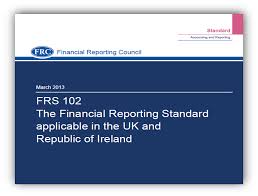
by John McCarthy Consulting Ltd. | Jul 15, 2024 | Blog, News
Below we compare the differences between FRS 102 (focusing on ‘small’ entities) and FRS 105 (‘micro’ entities) along with some other factors to consider when deciding whether to prepare accounts using the ‘small’ or ‘micro’-entities regime. The ‘small’ and ‘micro’ entities regime thresholds have changed recently. See our separate blog here about these changes.
An entity entitled to and choosing to apply the ‘micro-entities’ regime must apply FRS 105 The Financial Reporting Standard applicable to the Micro-entities Regime. The micro-entities regime is optional and therefore, when preparing their financial statements, entities may wish to consider the differences between applying FRS 102 The Financial Reporting Standard applicable in the UK and Republic of Ireland and FRS 105 when deciding on the most suitable regime. The links given here are to the January 2022 versions of FRS 102/105.
New editions of both standards are expected to be published in the summer of 2024, effective for accounting periods commencing on/after 1 January 2026.
Users of the accounts
The most important aspect to consider is the needs of users. Different stakeholders will have different expectations. For example:
- Suppliers/trade creditors
- Banks and
- Credit rating agencies may require more information than is provided by micro-entity accounts.
The level of information required by FRS 105 is very limited when compared to other standards, so be careful to advise your client about the implications for making a good impression on such stakeholders where that might be important.
Future growth plans
An entity that is entitled to either the ‘small’ or ‘micro-entities’ regime but is close to the size limits should consider carefully any decision on which regime to adopt. This is particularly relevant for a micro-entity if the business is expected to grow to the extent that it will be necessary to switch to the small entities’ regime in the near future. Transition from FRS 105 to FRS 102 Section 1A will involve significant changes to the presentation of the accounts and the accounting policies applied (see below).
Accounting Differences Between FRS 102 and FRS 105
Outlined below are eleven of the key accounting differences between FRS 102 and FRS 102:
|
TOPIC
|
FRS 102
|
FRS 105
|
| Revenue Recognition |
Section 23 completely revised (in the changes published in March 2024) to include a simplified version of the IFRS 15 Five Step Model effective for accounting periods starting 1 January 2026 with early adoption allowed from 1 January 2024.
See our July 2024 webinar on these changes called ‘The Main Changes in Irish GAAP’. |
Section 20 revised in a similar fashion to FRS 102 (in the changes published in March 2024) with the simplified version of the IFRS 15 Five Step Model introduced effective for accounting periods starting 1 January 2026 with early adoption allowed from 1 January 2024. |
| Leasing |
Section 20 is completely revised with the introduction of rules similar to those in IFRS 16, where almost all leases will go on balance sheet, and only certain types of operating lease will remain off balance sheet.
These changes are effective for accounting periods starting 1 January 2026 with early adoption allowed from 1 January 2024. |
No change to the previous regime of only capitalizing finance leases. All operating leases remain as they were before.
See our July 2024 webinar on these changes called ‘The Main Changes in Irish GAAP’. |
| Investment properties |
With the exception of investment property rented to another group entity, a revaluation each year is required, with changes recognised in profit or loss. |
Measured at cost less depreciation and impairment. |
| Property plant and equipment |
Measured at cost less depreciation and impairment but can choose to adopt a revaluation accounting policy for fixed assets of the same class |
Measured at cost less depreciation and impairment. |
| Intangible assets |
Measured at cost less amortisation and impairment but can choose in limited circumstances to adopt a revaluation accounting policy for intangible assets of the same class |
Measured at cost less amortisation and impairment. |
| Development costs and borrowing costs |
These costs can, subject to certain conditions, be capitalised. |
No option to capitalise. Must be expensed to the profit and loss account in the period in which they are incurred. |
| Trade and asset acquisition |
An intangible asset purchased with a business is normally recognised as an asset when separable and arises from a contractual or other legal basis |
An intangible asset purchased with a business must not be recognised separately from goodwill. |
| Financial instruments |
Financial instruments are divided into ‘basic’ and ‘other’ instruments.
The former are mostly measured at amortised cost, the latter mostly at fair value with movements generally recognised in profit or loss.
Entities can instead choose to apply the recognition and measurement requirements of IAS 39 Financial Instruments: Recognition and Measurement and/or IFRS 9.
The exception is directors’ loans which may be measured initially at transaction price. |
No distinction between ‘basic’ and ‘other’ with all financial instruments initially recognised at cost, which will be the transaction price. Subsequent revaluation or measurement of financial instruments at fair value not permitted.
For lending arrangements, simplifications are made in relation to the allocation of interest and transaction costs, and no requirement to calculate an effective interest rate.
Also, there is no requirement to impute a market rate of interest in arrangements conducted at non-market rates. |
| Equity-settled share-based payments |
Recognised at the fair value of the goods or services when received. For arrangements with employees, fair value is measured at the grant date and the expense recognised over the vesting period. |
Not recognised in the accounts until the shares are issued.
|
| Foreign exchange forward contract |
Recognised on the balance sheet as a financial instrument at fair value and the associated debtor or creditor retranslated at the year-end rate. Hedge accounting can be applied in certain circumstances. |
When a trading transaction is covered by a related or matching forward contract, the requirement is to use the rate specified in the contract.
If not matched to a trading transaction the cost of the foreign exchange forward contract will be recognised as a financial asset, unless it is not material in which case it will be recognised immediately as an expense in profit or loss. |
| Defined benefit pension plans |
Net interest on the net defined benefit asset or liability is recognised in the profit and loss account, and is calculated with reference to high quality corporate bonds i.e., the same rate is applied to both the plan assets and liabilities. |
Recognition of the surplus or deficit of the plan on the balance sheet not permitted. Agreed funding of deficit must, however, be recognised as a liability. Contributions payable to the plan accounted for as an expense. |
| Government grants |
Government grants can be accounted for using either the performance model or the accruals model. |
Requirement to use the accruals model.
|
| Deferred tax |
Based on timing differences |
No deferred tax |
Please see our latest CPD Webinar on The Main Changes in Irish GAAP (recorded July 2024).
See our webinar entitled ‘The Main Changes in Irish GAAP’ on the latest changes to FRS 102 here.
For more on the whole ISQM process for audit firms, please see our ISQM 1 Toolkit on our website here.
Please go to our website to see our:
- Anti-Money Laundering Policies Controls and Procedures Manual (March 2022) — View the table of contents
- AML Webinar (December 2023) available here, which accompanies the AML Manual. It explains the latest legal AML reporting position for accountancy firms and includes a quiz. Upon completion you receive a CPD certificate for attendance in your inbox.
- Letters of engagement and similar templates—Please visit our website here where immediate downloads are available in Word format. A bulk discount is available for orders of five or more items bought together.
- ISQM TOOLKIT, or if you prefer to chat through the different audit risks and potential appropriate responses presented by this new standard, please contact John McCarthy FCA by email at john@jmcc.ie.
- We typically tailor ISQM training and brainstorming sessions to suit your firm’s unique requirements. The ISQM TOOLKIT 2022 is available to purchase here.

by John McCarthy Consulting Ltd. | May 10, 2017 | News
FRS 102 – Interim relief for Treatment of Directors’ Loans
by John McCarthy
On Monday 8 May 2017, the Financial Reporting Council (FRC) issued a press release on director’s loan reporting for small companies. It has announced that it is withdrawing the requirement to find a market rate of interest where a loan is made on an off-market basis under Irish GAAP. This is an unusual move for the FRC, as it is making the change without consultation, presumably on the basis of demand from the profession.
In March, the FRC published Financial Reporting Exposure Draft 67 (FRED 67) which set out changes to FRS 102 as a result of the first triennial review, outlining potential changes to be made to director’s loans accounting. We will cover the changes in this FRED in a future blog.
The FRC has now responded to calls to create an interim optional exemption for small companies, allowing them to measure a basic financial liability that is a director’s loan initially at transaction price.
The FRC Press Release states: ‘A small entity, as an exception to paragraph 11.13, may measure a basic financial liability that is a loan from a director who is a natural person and a shareholder in the small entity (or a close member of the family of that person) initially at transaction price. Subsequently, for the same financial liability, a small entity is also exempt from the final sentence of paragraph 11.14.’
The measure announced applies to credit loans. The FRC has clarified that the interim measure will not apply to loans from small companies to their directors/shareholders i.e. debit loans.
As it is an interim measure, the amendment will be deleted as part of the finalisation of FRED 67, expected around January 2018. It will then be replaced with permanent requirements based on the proposal in FRED 67 after the outcome of the consultation process. The changes in FRED 67 are not expected to come into effect until periods commencing 1 January 2019, but early adoption may be allowed.
The FRC said: ‘Whilst it is usual for the FRC to consult formally on amendments to an extant standard, the FRC has concluded that this is not essential in this case as the amendment is only an interim measure, it merely defers for many entities the first-time application of an accounting policy of measuring such loans initially at present value and the permanent removal of this policy is already subject to an on going consultation.’
‘We have also explained that, in the context of owner-managed businesses in particular, many question the value of the notional interest charge to profit or loss in such circumstances, especially where the notes to the accounts adequately disclose the nature and terms of outstanding directors’ loans.’
For more on FRS 102 and the proposed changes in FRED 67 come to our next CPD course at the Talbot Hotel Stillorgan County Dublin on Monday 27 November. For more details and online bookings see here.
Other courses are also available at Ticket Tailor here.

by John McCarthy Consulting Ltd. | Nov 21, 2014 | News
Groups, stand alone companies and company directors may have, in the past, relied on informal arrangements and verbal agreements. They may now wish, as a result of the rule changes in FRS 102, to introduce more formal documentation to ensure their intentions are reflected in the contractual terms and in the accounting, so as to reduce any unintended consequences of these loans.
This latest blog in our series on the new accounting standard FRS102 considers the impact of its rules on an area that will impact most SMEs, namely, the accounting treatment for intercompany and directors’ loans.
This standard will impactnearly all privateentitiesinonewayoranother, fom 1 January 2015 and this particular topic of inter-company and directors’ loans will prove to be one of the most tortuous to explain to clients.
It is quite common for groups to manage their finances by setting up loans between parent and subsidiaries, or directly between subsidiaries. Many private companies in Ireland are owner-managed and long term loans between many company directors and their companies are very common.
These arrangements are mainly for commercial reasons and often allow cash to be used where it is most needed and may well be cheaper than using external finance, especially if the entity receiving the loan is perceived as risky so that the rate it could borrow at externally would normally be higher.
Often, though, the loans are not on any documented commercial terms. Perhaps they bear a low interest rate or more often no specified interest rate and no set repayment terms. This lack of formality in their repayment arrangements and these non-commercial aspects of intra group and directors’ loans can have ‘interesting‘ accounting consequences under trong>FRS102.
Initial recognition
Inter company loans, like all financial assets and liabilities, are within the scope of either Section 11 (‘Basic Financial Instruments’) or section 12 (‘Other Financial Instruments Issues’) of FRS 102. Most are likely to be in Section 11, being debt instruments .Most loans to and from subsidiaries that are repayable on demand are explicitly listed in section 11 as likely to fall within its scope.
These basic instruments are initially measured at ‘the present value of the future payments discounted at a market rate of interest for a similar debt instrument’. After this initial recognition they are measured at amortised cost using the effective interest method, which means an interest charge is recognised systematically over the life of the loan, giving a constant rate of return.
When a company adopts FRS102 for the first time, it must assess all of its accounting policies and ensure that the assets and liabilities on its transition date balance sheet (i.e. in most cases 1 January 2014) are measured in accordance with the standard (except where there are specific exemptions). The amortised cost method will, in most cases, cause interest charges/income to be recognised in spite of the absence of cashflows.
Where zero-coupon loans have previously been held, unadjusted, at their face value, the balances will need to be revisited to re-present them using the amortised cost rules in FRS102.
Example
Let’s take the example of Director A, a director of a Company B, a private company, which adopts FRS 102 in its December 2015 accounts and, therefore, has a 1 January 2014 transition date.
Let’s assume that at the beginning of 2012, B took a €100,000 interest free loan from A, its director, with a five-year fixed term. Assuming it can determine that a market rate of interest at the time would have been 12%. It goes back to the inception date in 2012 to establish what the accounting would have been from the outset. The revised presentation of the loan in the accounts under FRS 102 would be as follows:
| Year |
Opening balance |
Interest at 12% |
Closing balance |
| 2012 |
56,743 |
6,809 |
63,552 |
| 2013 |
63,552 |
7,626 |
71,178 |
| 2014 |
71,178 |
8,541 |
79,719 |
| 2015 |
79,719 |
9,567 |
89,286 |
| 2016 |
89,286 |
10,714 |
100,000 |
The 2013 closing value of €71,178 will be used as the carrying value of the liability in the transition date balance sheet at 1 January 2014, and the accounting continues from there.
FRS 102 is silent about the treatment of the difference of €28,822, According to the book ‘Manual of Accounting – New UK GAAP’ published by PwC in November 2013, (page 11014) states: “…in practice Director A would simply recognise the additional amount as part of the cost of investment in entity B…” Similarly B would recognise the loan liability at €71,718 and record the difference of €28,822 in equity as a capital contribution from the Director.
These numbers would of course, need re-adjustment as the discounted loan unwinds coming closer to maturity.
Protective measures
Few clients will find these accounting rule changes understandable or worthwhile. One response that is likely to be seen in practice is to ensure that there is documentation of all intercompany and director loans to include a term stating that they are ‘repayable on demand’, since section 12 of FRS 102 makes it clear that the fair value of an amount repayable on demand is not less than its face value.
Choosing to include this term, though, does mean that the receiving entity (‘B’ in this example) must show the whole loan amount as a current liability, which could damage the appearance of its balance sheet and thus hamper its ability to raise external finance in the future.
If a loan does not specify any terms, the default would normally be to assume it is repayable on demand, since the borrower has no enforceable right to avoid repaying the money.
Groups and company directors that have in the past relied on informal arrangements and verbal agreements may wish, then, to introduce more formal documentation to ensure their intentions are reflected in the contractual terms and in the accounting, and to help avoid any unintended negative consequences of these loan arrangements.
Relate Software Seminars – 2 – 4 December 2014
Meet John at the Relate Software Seminars taking place in Dublin, Galway and Cork on 2, 3 and 4 December respectively to hear more about this topic. Bookings with Relate at http://relatesoftware.selltickets365.com/
John McCarthy Consulting Seminars 15 and 17 December 2014
Some FRS 102 courses are taking place in Dublin on 15 and 17 December 2014, presented by John McCarthy, using journal entries to show how to prepare the first transition adjustments and the first set of FRS 102 financial statements.
- Camden Court Hotel, 15 December 2014 https://www.eventbrite.ie/e/frs-102-the-journal-entries-dublin-city-tickets-14533001599
- Red Cow Moran Hotel, 17 December 2014 https://www.eventbrite.ie/e/frs-102-the-journal-entries-dublin-red-cow-tickets-14532855161
NEW – FRS 102 Transition Checklist
This comprehensive FRS 102 Transition Checklist pdf publication will be available shortly for €50/ £40 + VAT . It will help users flag and address the issues that will arise on transition to the new accounting standard, which is effective for accounting periods commencing 1 January 2015 and will require the comparatives aligned with FRS 102 from the transition date which for December year ends is 1 January 2014. Watch for our upcoming blog announcing this publication.
John McCarthy FCA, Dip. IFRS, Dip. Insolvency, Certificate in Irish and UK GAAP is Director of John McCarthy Consulting Limited.
He offers consulting and training services to the accounting profession on audit, accounting, insolvency and practice management issues.

by John McCarthy Consulting Ltd. | Jul 9, 2014 | News
Nine Key Differences Between Current Irish/UK GAAP and FRS 102
Introduction
The article examines the more common areas of difference between the existing Irish/UK GAAP i.e. the existing FRSs/SSAPs and UITF (Urgent Issues Task Force) pronouncements and new Irish GAAP. The new Irish/UK GAAP is called FRS 102 and it comes into force for accounting periods commencing on or after 1 January 2015.
Background to the Development of FRS 102
The Financial Reporting Council (FRC), or the Accounting Standards Board (ASB) as they were previously known until July 2012, commenced a project to replace Irish and UK GAAP about ten years ago. This went through various iterations including a version of the IFRS for SMEs which was later transformed into the ‘FRSME’ (FRS for Medium Entities) published in late 2009. However following wide scale feedback from the profession and from users of financial statements, FRS 102 was ‘born’. Copies of the standard are available in the publications section of the FRC website at www.frc.org.uk.
The new FRS was published in March 2013 preceded by two accompanying standards, FRS100 and FRS 101 (both published in November 2012) which also need to be read for a full understanding of the application of the standard. The complete titles of the new standards are:
· FRS 100 Application of Financial Reporting Requirements
· FRS 101 Reduced Disclosure Framework – Disclosure exemptions from EU –adopted IFRS for qualifying entities
· FRS 102 The Financial Reporting Standard applicable in the UK and Republic of Ireland
These three new standards replace the entire suite of FRSs/SSAPs and UITFs for medium/large private entities in the UK and Ireland.
The ‘transition date’ for companies with a December year end, has already passed since 1 January 2014. In fact 2014 will be a busy year for accountants as two sets of financial statements need to be prepared – one set under Irish/UK GAAP`(the last ever using SSAPs and FRS 1 to 30) and another set under FRS 102 which will act as comparatives for the 2015 financial statements.
Early adoption of the standard was allowed and at least one company that has early adopted the standard is Travelodge UK Limited. It adopted the standard for the financial year ended 31 December 2012 – using FRS 102 to prepare the 2012 accounts as soon as it was published in March 2013.
Small entities and the FRSSE
It was originally intended that ‘small’ entities (i.e. those with turnover of less than €8.8m, gross balance sheet assets less than €4.4m and less than 50 employees) could opt to use the FRSSE (a cut down version of old UK/Irish GAAP).
However, recent developments at EU level (with the announcement of the Micro Entities Directive for companies with turnover less than €700,000, gross balance sheet assets less than €350,000 and less than 10 employees) mean that the FRC are currently re-thinking the whole FRSSE project. While the latest incarnation of the FRSSE is due to apply from 1 January 2015, it now looks like it will be replaced by a version of FRS 102 which some commentators believe may be a type of FRS102 ‘lite’. Only time will tell what the FRC will produce, so watch this space.
Terminology
This article does not deal fully with the many changes in terminology brought about by the implementation of the new standard, but some of them are listed here:
|
Current Irish GAAP Term
|
FRS 102 Term
|
|
Profit and loss account
|
Income statement/statement of comprehensive income
|
|
Balance sheet
|
Statement of financial position
|
|
Cash flow statement
|
Statement of cash flows
|
|
Profit and loss reserves
|
Retained earnings
|
|
Statement of recognised gains and losses
|
Statement of changes in equity
|
|
Minority Interest
|
Non-controlling interest
|
Because the current Irish GAAP terms are retained in Irish and UK company law, the law trumps FRS 102 and we are unlikely to see many companies change these terms.
The main technical differences with which accountants and their clients will have to come to grips, in the next six to 12 months are set out below.
Nine key differences
1. Financial instruments
The single biggest difference between ‘old’ and ‘new’ UK/Irish GAAP is that regarding financial instruments which includes cash, trade debtors and trade creditors. Space does not allow us to go into all the details, but suffice to say that even in a simple company or group, accounting for financial instruments will be more complex than in the past.
For example, an interest free loan (deemed to be a ‘basic’ financial instrument) between two companies or between a director and their company is deemed to be a basic financial instrument which, in certain circumstances, will need to be accounted for at amortised cost. Certain other financial instruments will be accounted for at fair value.
2. Goodwill
Under current Irish GAAP goodwill is dealt with under FRS 10 and purchased intangibles are amortised over their useful life which cannot exceed a maximum period of 20 years, subject to a rebuttable presumption that includes both the demonstrable durability of the business and the feasibility of an annual impairment review.
Under FRS 102, intangibles such as goodwill must be amortised over their useful lives but where the entity cannot make a reliable estimate of the useful life, that period should not exceed 5 years. This will impact entities that have goodwill on their balance sheets and cause amortisation to be accelerated, thus depressing reported reserves.
3. Deferred Taxation
There is a major difference between the treatment of property revaluations between the existing Irish GAAP standard FRS 19 Deferred Tax and the new FRS 102.
FRS 102 has reintroduced the local standard requirements of FRS 16 ‘Current Tax’ and FRS 19 ‘Deferred Tax’ but has added some additional requirements which will, in certain cases, increase the amount of deferred tax reported on company books.
In effect it means that if a company revalues its property it must provide for deferred tax at the tax rate that is expected to apply when the timing difference reverses. The same applies in a fair value exercise during a business combination, deferred tax must be provided on similar grounds. That is an attempt to bring the new UK/Irish standard fairly close to the ‘temporary difference’ approach taken by the IASB (International Accounting Standards Board) in full IFRS.
As above, this will often cause some positive and negative changes in reported reserves under FRS 102 compared to current Irish GAAP.
4. Statement of Cash Flows
This statement is quite different (apart from the change of title) from the Cash Flow Statement in current Irish GAAP, called FRS 1, in that there are only three headings instead of nine. These three headings are – ‘operating’, ‘investing’ and ‘financing’ activities. This means that a number of cash flows will be recorded in different headings by different companies, depending on what choices they make.
For example interest payments, interest receipts and dividend receipts can be recorded under about eight different headings, depending on choice and the standard needs to be referred to for the choices available. Even tax paid has no specific section, although it is expected that most of it will be allocated to ‘operating’ with only capital gains tax being likely to be recorded within the ‘investing’ section.
The movement in cash flow is also different in that the reconciliation is to the increase/decrease in cash and cash equivalents rather than just cash, as in FRS 1. In practice this is unlikely to cause problems as cash equivalents are only short term investments that are highly liquid and held to meet short term commitments rather than for investment purposes.
There is no formal reconciliation of the movement in cash to the movement of net debt as in the current FRS 1 but they should both be reconciled so as to ‘prove’ the statement is correct.
5. Investment Property
Investment properties are initially recorded at cost under FRS 102. Subsequently if a fair value can be measured without undue cost or effort then, it must be fair valued with any gains and losses being reported within the Income Statement (new title for the Profit and Loss Account).
If a fair value cannot be measured reliably then it is accounted for as a normal item of property, plant and equipment, at cost and subjected to depreciation.
This accounting treatment is different from the current SSAP 19 ‘Accounting for Investment Properties’ in a number of respects.
Under SSAP 19 a reporting entity:
· must adopt a revaluation model and not charge depreciation; and
· must record all revaluation gains and losses in reserves and in the Statement of Total Recognised Gains/Losses, not the Profit and Loss Account.
For some entities this will result in potentially greater volatility of future company results as gains/losses on investment property revaluations/devaluations will impact directly on income.
6. Leases
Leases are currently dealt with under SSAP 21. The major difference between SSAP 21 and FRS 102 regarding leasing is in the disclosure requirements.
Under the new FRS, for operating leases, entities must now disclose the total amount of non-cancellable operating lease rentals due right to the end of the contract must be split between the amounts due:
· within one year;
· between two and five years and;
· over five years.
In SSAP 21, only the annual commitments expiring within one year, between two and five years etc. are required to be disclosed.
7. Employee benefits
Under current Irish GAAP, employees’ short term entitlements such as untaken holiday pay, are ignored and rarely accrued. However under FRS 102 the cost of all employee benefits must be recognised:
· as a liability after deducting amounts already paid directly to employees; and
· as an expense, unless the cost can be included within inventories or in the cost of property.
Therefore accruals for employees’ untaken holiday entitlements will need to be accrued, giving rise to a once off reduction in reported profits in the first year of implementation of FRS 102.
These entitlements should be measured at the undiscounted amount of short-term employee benefits expected to be paid in exchange for an employee’s service.
The expected cost of accumulating compensated absences should be recognised when the employees render service and measured at the additional amount the entity expects to pay as a result of the unused entitlement accumulated at the end of the reporting period. These are presented as current liabilities.
8. Foreign currency
Under current Irish GAAP, SSAP 20, the contract rate (the rate of exchange specified in the contract between the parties) may be used. However, under FRS 102, the contract rate is not allowed.
Another totally new concept in FRS 102 is that of the ‘functional currency’ – a definition borrowed from full IFRS. This is defined as the currency of the primary economic environment in which an entity operates.
For many Irish private companies it will be obvious that the Euro will be the functional currency of the company but there are a number of subsidiaries of US multi nationals who have had to record their transactions in a foreign currency as their dominant currency is the dollar. Similarly for many UK based entities their functional currency will be Sterling. For these there will be little change from this adjustment to the definition.
For others it will involve considerable judgement in deciding what an entity’s functional currency is. Under SSAP 20 there was no ‘functional currency’ definition, as records had to be kept in the company’s local (geographical) currency.
9. Specialised activities – agriculture
Current Irish GAAP does not deal with the accounting treatment of specialised activities like agriculture. However, FRS 102 addresses the accounting for biological assets defined as living plants and animals. The treatment suggested is a choice between the ‘cost’ model and ‘fair value’.
Summary
At least in the short term, FRS 102 will create some volatility for most reporting entities.
The sooner accountants and their clients come to grips with the key differences and make sure their financial reporting software and systems are well prepared to cope, the better.
A series of courses is taking place around Ireland, presented by John McCarthy, using journal entries to show how to prepare the first transition adjustments and the first set of FRS 102 financial statements for 2014. For more details of location and booking options visitwww.jmcc.ie/events.
John McCarthy FCA, Dip. IFRS, Dip. Insolvency, Certificate in Irish and UK GAAP is Director of John McCarthy Consulting Limited. He offers consulting and training services to the accounting profession on audit, accounting, insolvency and practice management issues.
He may be contacted at 00 353 86 839 8360 or e mail john@jmcc.ie.
For more information see www.jmcc.ie










